Disclaimer: This article covers the basics of TV talk show production – from the production process to a more detailed discussion of common problems and solutions. Feel free to use the table of contents below to navigate to the most relevant sections … or enjoy reading the whole article — because why not! 🙂
Producing any type of TV show is a huge undertaking, with many moving pieces that can easily fail — from inaccurate planning and malfunctioning equipment to shooting delays and problems that can arise from many other oversights.
What if you add guests and unscripted conversations to this messy equation? Well, you’ll get a recipe for a disaster unless you make sure your talk show production process is as automated and collaborative as possible.
In this Ultimate Guide, we will explain:
- How talk shows are created — from ideation to post-production
- What are the most common challenges you will encounter when producing a talk show and how to use Cuez to automate and streamline talk show production?
- What the future holds for TV pros working on talk shows
So buckle up, get ready to take (many) notes, and let’s dive in!
Creating a TV Talk Show: From Ideation to Post-Production
If you’re reading this article, you probably already know what a talk show set looks like. Or maybe you even produced a show like that yourself. Or you’re just thinking about creating one inspired by The Graham Norton Show, Ellen or The Tonight Show.
All talk shows are produced in a slightly different way, depending on how often they air (daily shows require more automation and are more prone to mistakes than weekly shows), what kind of guests (and how many) are invited, how many different camera angles are required, etc.
However, we can generally divide TV talk shows into 5 key stages:
- Commissioning a talk show
- Planning the set
- Pre-production
- Shooting (i.e. production)
- Post-production (in the case of pre-recorded shows)
Let’s have a look at what happens at each stage, starting with pitching a talk show and structuring your dream team.
Pitching the Talk Show: Commissioning Process
As Earl Nightingale once said, ‘everything begins with an idea’ or — in the case of TV talk shows — with various ideas pitched to a broadcaster by television production companies to secure a free time slot. This process is called commissioning, and the broadcaster’s final decision is based on many criteria, for example:
- Budget implications (how expensive it will be to produce this talk show).
- Current trends (how popular the talk show can become, based on what’s trending at the moment).
- Target audience vs. timing (is this the right type of talk show, considering the airing time and target demographics).
The proposals submitted by the production companies can be limited to just explaining what the talk show will be about (which leaves more freedom for the broadcaster’s commissioning team to modify the idea).
However, some applicants can already have a host for the show and a more detailed breakdown of the recurring show segments or even a mock episode recorded in a café (or an office) that helps to accurately estimate the budget and visualise the idea.
The commissioning process usually takes up to a couple of weeks (like at UKTV Corporate Sites). Once a talk show receives a green light, it’s time to build a dream team and start the pre-production stage.
Designing a TV Talk Show Set and Building a Dream Crew
Before we describe the different roles and responsibilities of people working on talk show production, we’d like to emphasise that there isn’t just one “best” way to organise the team, as the production process is very complex. So, this is one way the crew structure can look like:
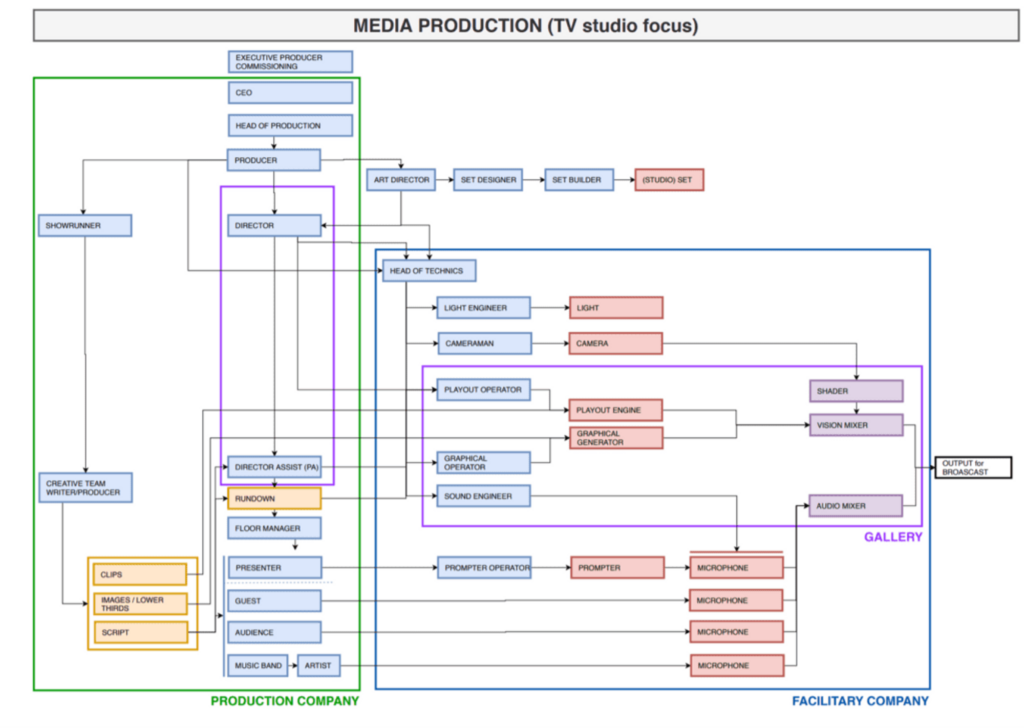
Every talk show needs someone who will decide on the content of a show, which topics will be covered in the recurring segments, or even who will be the face of the show (i.e. the host). That person is sometimes called a showrunner. But (depending on the country) they’re also referred to as the Executive Producers or Series Editors, especially in the UK.
Every TV show also needs a producer — someone responsible for the day-to-day production activities: from planning and organising content to overlooking the shooting. However, the talk shows will almost always have a small army of such people with slightly different roles:
- Day Producers: they usually work on daily talk shows and take turns managing production days throughout the week.
- Segment (Rubric) Producers: they are assigned to specific, recurring talk show segments (e.g., a cooking segment or a health tips segment), and are responsible for preparing content and research for the segment they’re assigned to.
- “Guest” Producers: while this isn’t a formal job title, these producers are strictly responsible for gathering materials on their guests, inviting, and prepping them (to make it easier for the host to predict where the conversation will go).
Around the time when the producers are assigned to the talk show, the production company finds an (Art) Director — someone who will design the set and turn the idea from a concept to being production-ready.
Our own Erik Hauters, the founder of Cuez, who has directed over 2,500 talk shows (!) gave us some insights on the role of a Director in producing TV talk shows and where he usually starts:
“The Series Editor gives me some requirements about the set, like it needs to be light, have a female touch, etc. — a general briefing. I then make a mood board, I make a rough camera plan, and then I present it all to them. If the Series Editor likes it, I then pitch it to the Set Designers.”
If you are not familiar with the term “mood board” that Erik is referring to, it’s a compilation of visualisations that dictate the “feeling” of the show. Here are some great examples of mood boards. Below you can see one that was created by Erik for one of his shows (some of his mood inspirations, the location he used, and the final effect):
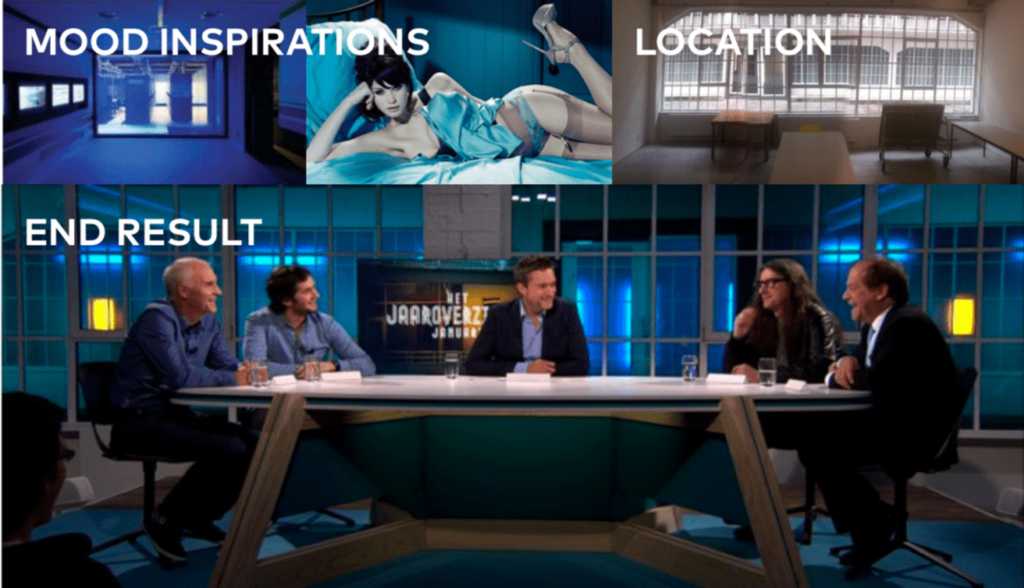
The Set Designers then visualise the Director’s idea by rendering the set in 3D, including different camera shots (close-ups, top shots, etc.) with “real people” in them, which will look like this (the render is at the top, and the final set design is right below it):
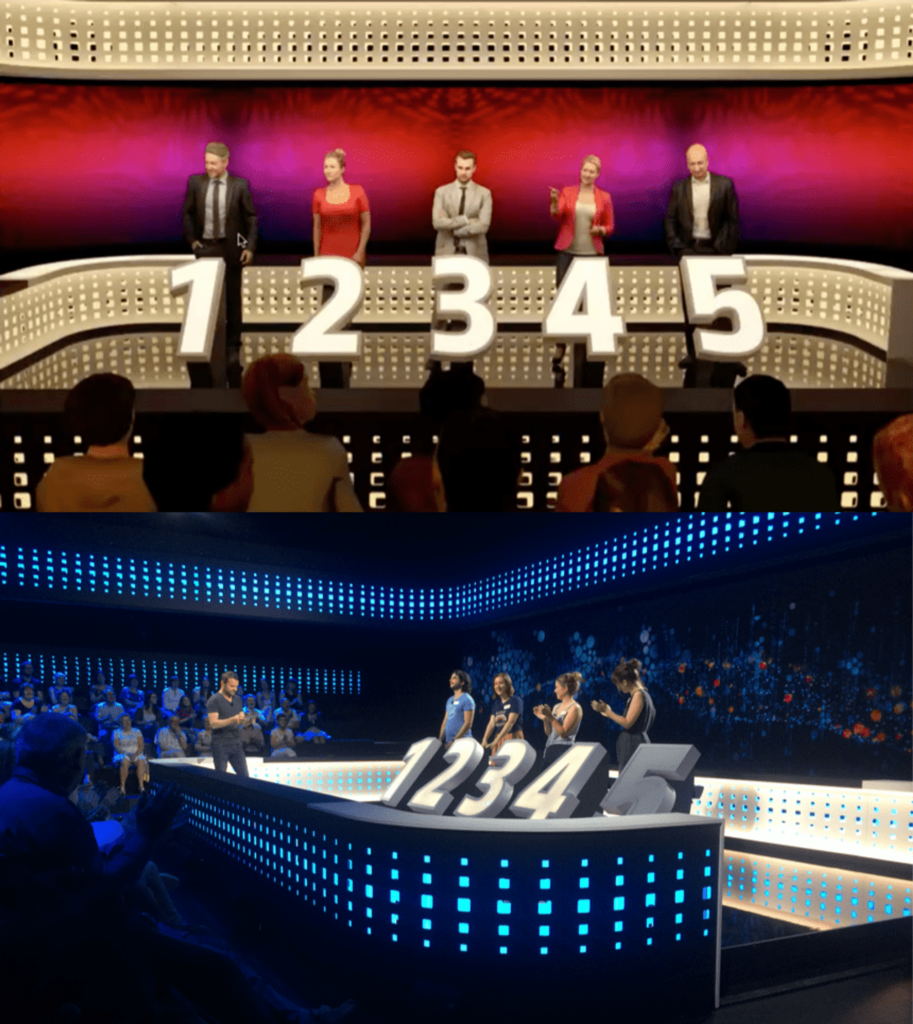
The (Art) Director and Set Designers work closely together to create a complete visualisation that they can pitch to the Series Editor and (often) to the broadcaster.
While artistic freedom is welcome at this stage, the team needs to make sure to plan within the budget that has been agreed upon with the broadcaster, which also limits the number of cameras (and the camera crew).
Sometimes it’s possible to enhance the set design by using automated (or “unmanned”) cameras — Erik explains how to do that in his case study article, where he describes a daily game show set design consisting of 10 cameras with only 3 operators!
Speaking of the budget, producing a daily TV talk show can cost as much as €65,000 per episode (in Belgium), which adds up to €2.6m for a 40-episode series.
This sum needs to cover both in-house and outsourced parts of the production, such as hiring freelancers (graphic designers, make-up artists, etc.) and paying a production facility company (like EMG, NEP or dock10) for their equipment and staff (cameramen, light engineers, sound engineers, OB van crew).
The production costs can often be lowered by finding the right sponsors who will help equip the dream set — Erik once travelled to Zürich to finalise a deal with a furniture company that would provide “the perfect couch” for his talk show!
Apart from all the roles that we’ve already mentioned and that are involved in early pre-production, there are also people responsible for welcoming and warming up the talk show audience on the shooting day, but no production can be successful without the “busy bee”.
That ”busy bee” can have many names — the Director Assistant (DA), the Script Supervisor, or (most often) the Production Assistant (PA). Their job is to glue all the key crew members together on the shooting day and facilitate communication between the Director, the host, and the engineers.
The PA is also responsible for creating a rundown — a technical representation of the script (more on that later).
While there can be many other production roles, depending on the type of talk show that you create, we’ve listed the key roles that any crew almost always includes these days.
Now that we’ve covered the people, let’s have a look at what happens between finding the dream team and shooting an episode.
Pre-Production of a Talk Show: from a Café Test to Recording the “Zero”
Many talk show pre-productions start outside of the actual recording studio, in a test environment. These are usually called café or bar tests after the name of the location they are recorded at.
The crew rents out a small venue and simulates the whole pre-production cycle — from creating a script (and a rundown) and preparing individual segments to record mock episodes with the actual host and guests.
It’s also a common practice to record these trials in the office, with a very provisional set design like this:
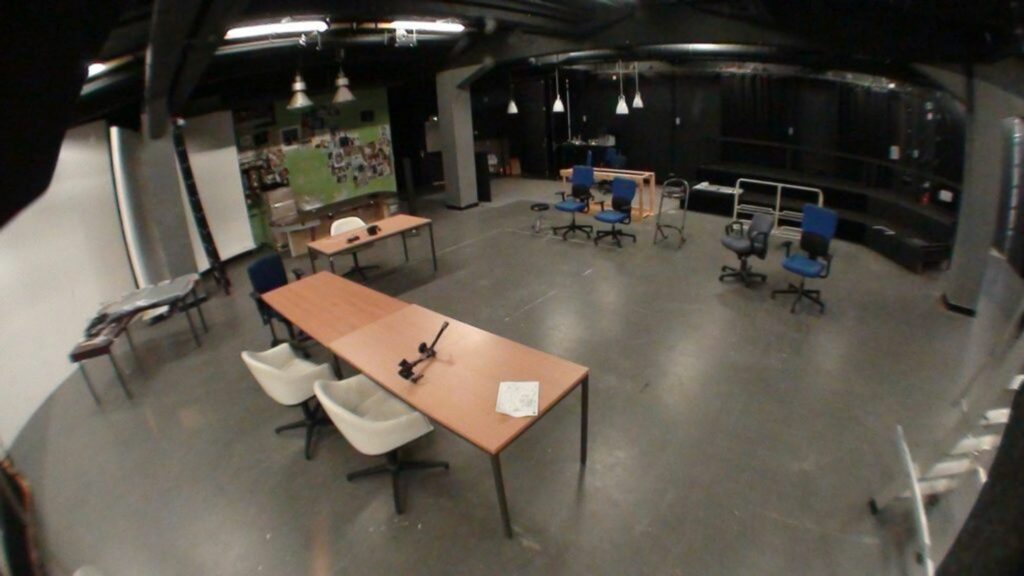
Why would you record a café test? Here are the main reasons:
- The team gets to rehearse the pre-production work cycle to identify the elements that should be improved (e.g. communication between the technical team and the in-house producers).
- It’s much cheaper to set up a café test environment than to build a talk show set, only to change it every time an adjustment is needed (it can cost €25-€300k/day to rent out a staffed studio!).
- Iterations in this setting are much quicker and easier than in a real studio.
- Testing can be done while the actual studio is still being built, which helps fine-tune the structure of the talk show before entering the final location.
As a result, after a couple of days of tests and improvements, the team is ready to record the ‘zero’ — a start-to-finish simulation of an episode recording.
All the steps leading to recording the zero can be very show-specific (different crews = different approaches). However, the pre-production steps of every talk show episode that will eventually air are more structured and ‘regulated’.
We created Cuez to help automate them, but before we boast about what we do, let’s take a closer look at those steps.
Pre-Production of a Talk Show: Planning Episodes
Planning is the key element of the talk show pre-production, especially if we work on a daily talk show with numerous guests and segments to manage every week. But even weekly talk shows need a robust planning tool and a way for the whole team to brainstorm ideas.
That “tool” for way too long has been… a big whiteboard.
The creative team (writers, producers, etc.) use post-it notes to mark important events (like a presidential visit or a national holiday) and pinpoint guests/segments to a specific shooting day.
A post-it note usually contains a guest’s name (‘Interview with Will Smith’) or a more generic action to take for more distant episodes (‘Invite someone to discuss Halloween traditions’).
Here’s an example of a typical planning room, with lots of notes and a whiteboard (or — in this case — a blackboard) to organise the content of each episode:
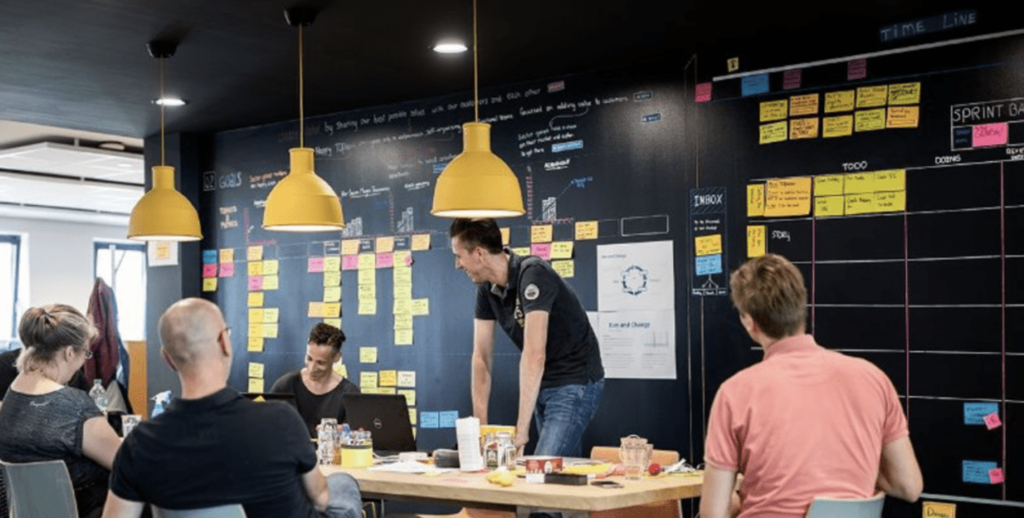
Work is assigned to producers during short daily briefings. At this stage, their role is to:
- Communicate with the future guests (which involves finding their contact details, inviting them, and prepping them with questions that the host will ask).
- Prepare a “dossier” (a brief) on future guests, which will serve as an all-in-one knowledge base about the guest. The dossier should contain any previous research that has been done about them, their contact details, photos, and the information about why they are invited, what they are likely to say when interviewed by the host, etc.
The brief/dossier is often a physical item — a folder containing photos, sheets of paper, and printouts. Some broadcasters have actual archives where they store past research that they make available to production companies to facilitate the pre-production process.
When all the materials necessary for recording a talk show episode are ready (and all guests have been invited and confirmed), it’s time to flesh out a script.
Pre-Production of a Talk Show: Creating a Script and Turning It into a Rundown
Creating a script for a (daily) TV talk show is usually handled by the Day Producer.
They review all the briefs prepared by the other producers and write a script that includes the textual content (i.e. the questions for the host or their intro monologue) and the media (photos, aka stills, videos, soundtracks) that they’d like to have played during the episode.
The host receives the script, usually via email, and works with the Day Producer to finalise it (at least for now…). This step sometimes takes a long time when the host’s and producer’s visions differ. Then the iteration process is quite painful (an endless email back and forth).
However, once the script is agreed upon, the Production Assistant (PA) then turns it into a rundown (also known as a cue sheet or a timeline) — a minute-by-minute (or even second-by-second) breakdown of the show, with separate columns for the technical team to help them understand when to show/play what, camera angles, etc.
Here’s an example of a typical Excel rundown (which is far from ideal, as you’ll see in the next paragraphs):
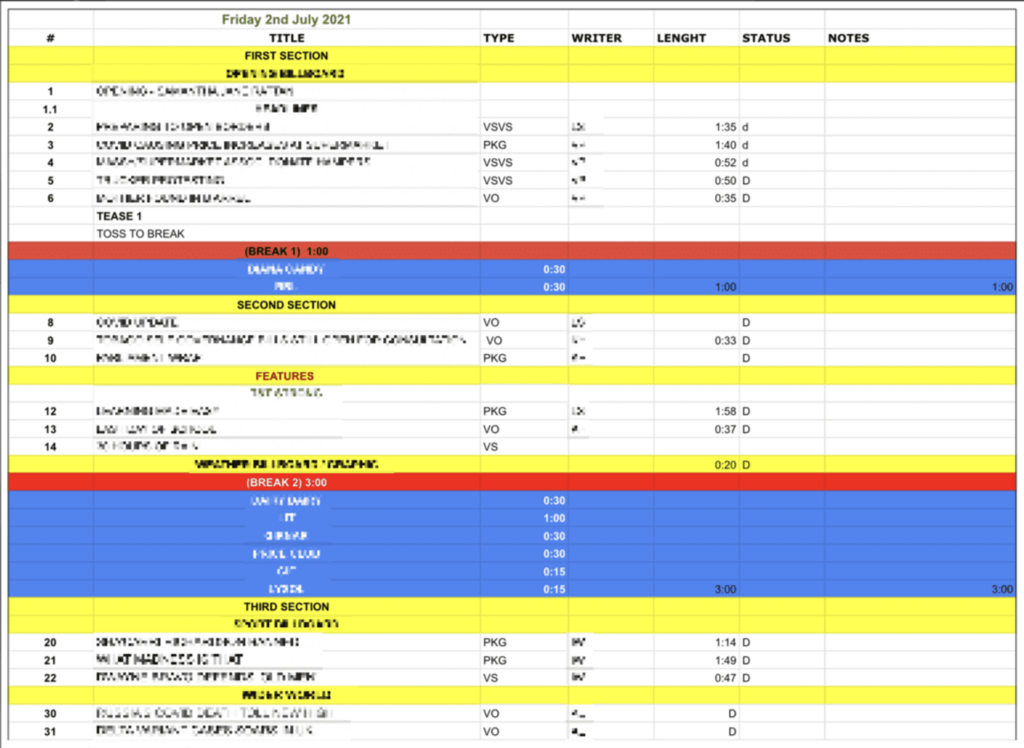
There’s one more element that needs to be created at this point — the cue cards. These are physical cards (although more modern productions use tablets) that are less detailed than the actual script so that the host can comfortably hold them and refer to them during the shooting.
While not all talk shows have transitioned to using digital cue cards yet, more and more of them are doing so — like The Graham Norton Show (the ‘paper’ beginnings on the left, the ‘digital’ present on the right):

All you have to do is to print out the script, the rundown, and the cue cards. And this is the moment when the printer breaks down 🙂 . That’s one of the reasons why more and more talk show productions are becoming fully digital (with Cuez).
Talk Show Production Stage: Rehearsals
Assuming that the printer did work and all the key materials had been printed out, it’s time to deliver them to the key team members and get everyone ready in their positions — the Autocue (Teleprompter) Operator receives the script, the Director goes to the production control room (PCR, also called a studio control room, SCR, or simply a gallery), and everybody arrives at the talk show set to start the rehearsals.
The rehearsal is essentially a meeting during which the producers play the roles of the guests. They answer the host’s questions based on the prep talks they had with the actual guests. It is filmed by the camera crew as if it was a real recording. This way, they can practice some unusual shots (e.g., following a guest entering the set with the camera).
If there’s also a musical guest, they get to rehearse their performance a couple of times.
It is after the rehearsal that the production madness truly begins. If the Day Producer made extensive notes on what to keep/change/delete from the actual recording, the “adjustment workflow” looks more or less like this:
- The Day Producer discusses changes with the host;
- The PA adjusts the rundown and communicates it to the Teleprompter Operator;
- The Director is informed about any post-rehearsal changes.
The script and rundown get reprinted and handed over to the key crew members. Finally, everybody is ready to record the episode — just a few final touches left:

Shooting and Post-Production of Talk Show Episodes
Talk shows episodes are usually recorded in two ways — live or pre-recorded (live-on-tape), meaning there are several hours between recording and broadcasting. This allows for reshooting some scenes, but the disadvantage is that the show loses momentum. The guests and the audience are tired and less “lively” compared to a live talk show.
If the show is pre-recorded, the Day Producer meets with the host to discuss what to cut out of the final recording. They then sit together with the editor to finalise the post-production.
Back in the day, since the shooting rarely happened in the broadcaster’s building, a crew member (the producers or the Director) had to deliver the recording to the broadcaster, with multiple security protocols to follow. Luckily, recently, this step is now digital for most TV productions.
Reviewing Talk Show Production and Learning From Mistakes
Broadcasting the episode doesn’t end the lifecycle of a talk show episode production. Shortly after the shooting day (usually the next morning), the team gathers to discuss what went well and what to improve in future episodes.
This process can be very problematic for the daily talk show crew, with new guests and segments created every day, so having a way to reliably reflect on the timings, rundowns, and scripts is crucial.
To better visualise the complexity of the TV production cycle, here’s a chart that we created to summarise this mind-boggling process:
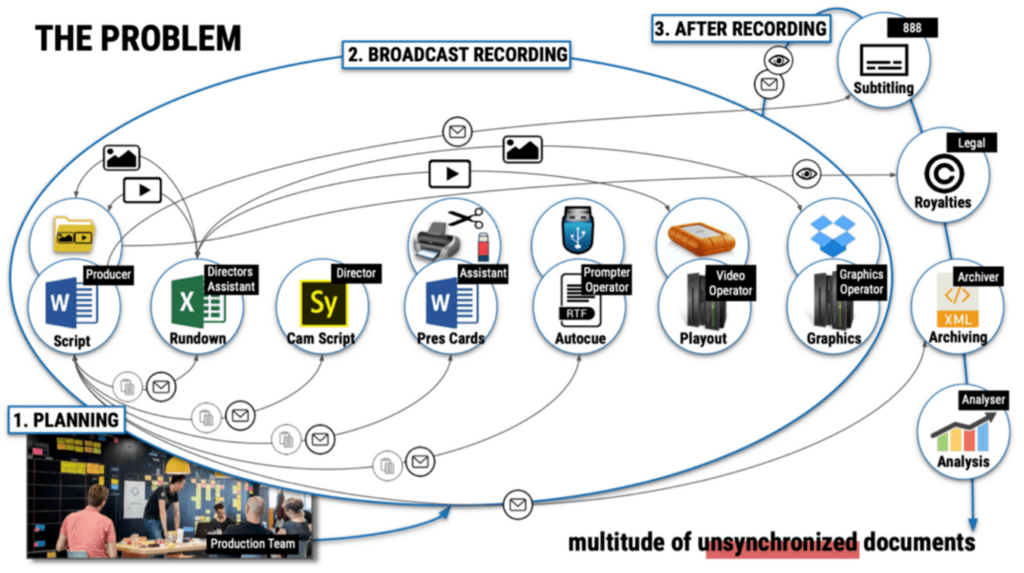
TV Talk Show Production: Challenges and Problems
As you can see, talk show production is a process that can go wrong at almost every step. Human and technical errors, delays, equipment malfunctions, and last-minute changes — can be avoided with the correct tools that have become available for the talk show production industry.
We created a short infographic to summarise the biggest challenges that we’re now going to discuss in detail:
Let’s have a look at the most error-prone steps in the production cycle and how modern TV crews can use technology to avoid these errors and make their work more collaborative and automated.
As a response to the challenges listed below, we offer Cuez and TinkerList as an optimal solution. Both platforms possess various unmatched features, making production a piece of cake.
Challenge #1: Planning Talk Show Episodes and Managing a Production Calendar
We already described a very common scenario when organising the pre-production, with the whiteboard being the central reference point and a brainstorming outlet for the team. Relying on a physical object for such a fluid and collaborative element as planning can cause numerous challenges.
It gets really messy — really quickly:

Post-it notes + markers = planning disaster
Let’s admit it – using Post-it notes and non-permanent markers to manage a talk show production has to end up badly. The notes fly off the whiteboard, the markers erase easily, no version management… The team will eventually lose track of who wrote what and when. In other words, the planning gets messy and out of control in no time.
Lack of a centralised knowledge base
Speaking of detailed plans. When you use an analogue planning system in talk show pre-production, your notes in the calendar are just that — notes. Producers’ research, the creation of a guest brief (dossier), it all happens off the board.
You’ll end up with many files scattered around Excel (or Google) sheets, documents, or even on physical sheets of paper.
Apart from being a messy and error-prone system, it brings a lot of limitations to collaboration during the pre-production process. That finally brings us to the biggest challenge in creating a talk show calendar…
Limited planning space
Have you ever tried using a whiteboard to plan out your week? What about creating a whole-month calendar with detailed notes about what you’ll do every hour of every day? Planning a talk show is like that, but a hundred times worse.
Talk shows usually have anywhere between 13 and 365 (!) episodes. Depending on whether it’s a weekly or a daily talk show. Each episode can be then broken down by recurring segments and guests. So being limited by physical space (the size of the whiteboard) makes it impossible to plan many episodes in advance.
This results in lower quality, chaos, and mental shortcuts written on the board instead of detailed plans days (or weeks) in advance.
Making episode planning collaborative
Producing a TV talk show is rarely a process where everybody involved in it sits in the same room X hours a day. You have freelancers working off-site, and with the pandemic, a big part of the team is often working remotely.
As an effect, two things tend to happen — you either exclude some crew members from the planning process (because they can’t see the whiteboard) or you waste a lot of time (and nerves) trying to include them by running around the conference room with a camera or sending pictures of the whiteboard, zooming-in on individual items written on it.
It’s a mess. But it doesn’t have to be.
Automating Planning and Production Calendar Creation with TinkerList
One of TinkerList’s key features is Calendar — a fully collaborative way to schedule talk show guests and plan crew’s activities:
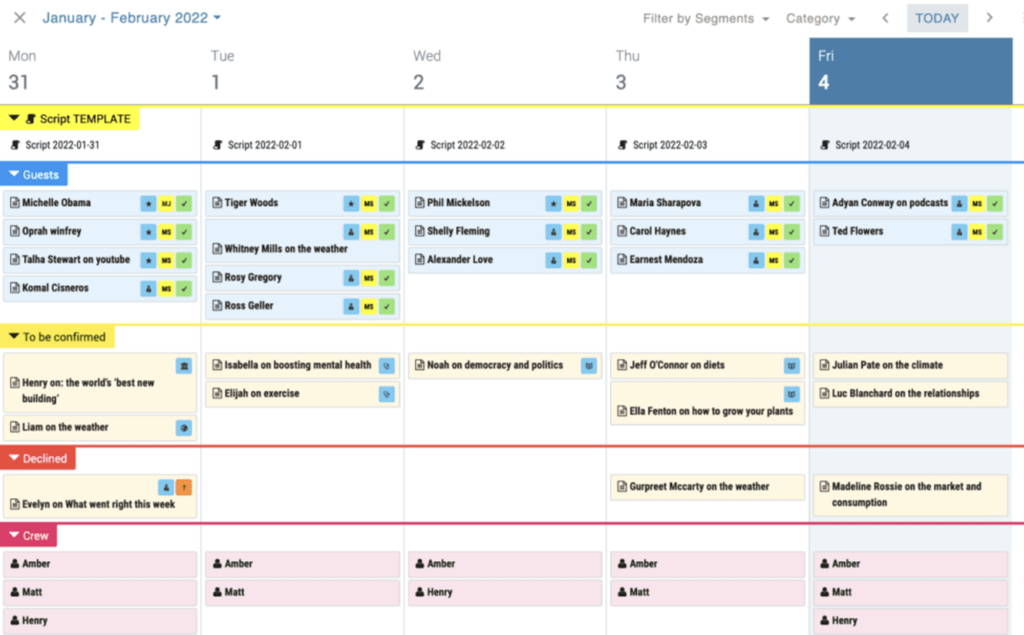
The Calendar feature allows talk show crews to:
- Plan weeks (or months) ahead, pinpointing the future events and tasks to complete before upcoming episodes.
- Create Cards that contain the show segments’ titles (or guests’ names). They also act as briefs/dossiers and can store contact details, notes, and rich media in the cloud.
- Work collaboratively on the show production. All team members, whether on-site or off-site, can follow the plan, contribute, add notes and discuss ideas.
- Forget about the messy whiteboard, post-it notes, and non-permanent markers. Everything is securely stored in the cloud and easily accessible by everybody, at all times.
Challenge #2: Writing, Editing, and Collaborating during a Talk Show Production
Preparation process
During the research process, producers often refer to archived data and update what had already been done in the past.
When they finish searching through Google Drive or physical files (!), they need to create their parts of the script. And there’s usually no script template they can use to organise their findings into an easy-to-follow structure.
As a result, Day Producer edits disorganised parts of the scripts, based on the files sent by other producers. That causes delays and makes the responsible team members mad pretty quickly!
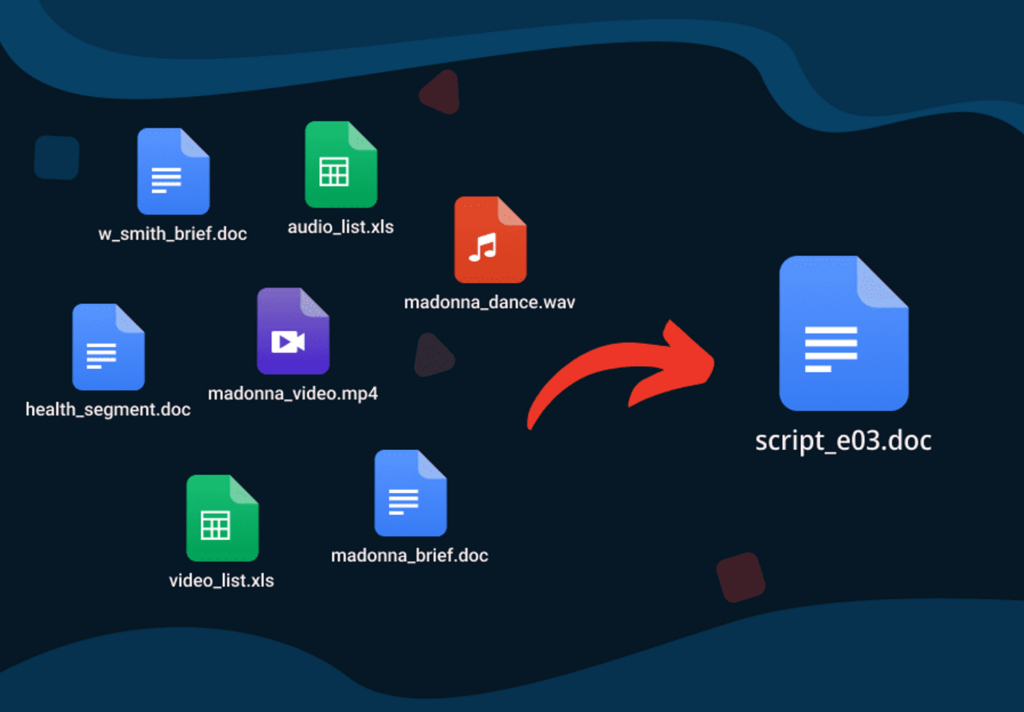
Managing talk show script versions
Finalising a script merely means finalising its first version. Production of daily talk shows is all about last-minute changes and edits. If there is no script automation, the Day Producer needs to revisit the original “final script” numerous times:

Keeping the team in the loop about script edits
The last-minute changes to the script are inconvenient both practically and collaboratively. At some point, it becomes simply too late to communicate the edits to the entire production team. Especially to the host, director, and technical team.
A faulty system
Apart from being a messy and error-prone system, it brings a lot of limitations to collaboration during the pre-production process. The more talk show segments, guests, and responsible team members there are, the messier and more uncontrollable the process becomes.
And that finally brings us to the biggest challenge in creating a talk show …
Making Production Collaborative
Producing a talk show is rarely a process where everybody involved is in the same room for X hours. You have freelancers working off-site, and with the pandemic, a big part of the team is often working remotely.
As an effect, including all crew members equally in the planning, production, and collaborating on a script/rundown becomes problematic. That slows the production process down.
It’s a mess. But it doesn’t have to be.
Collaborative Production with Cuez and TinkerList
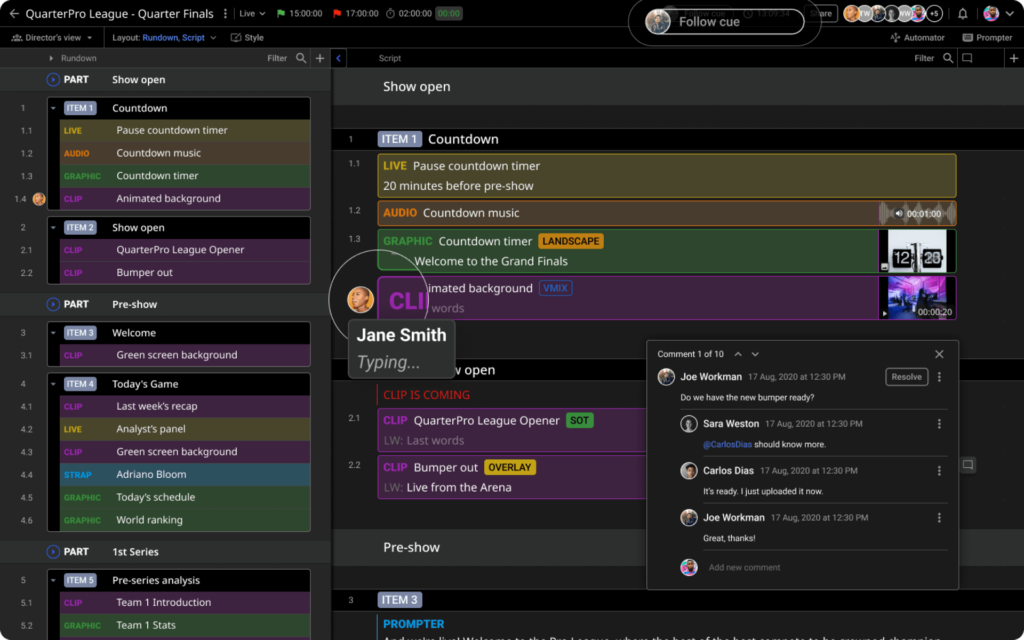
Cuez was created with a big goal in mind — to allow the whole team to collaborate on the production process, increase transparency of the edits, and keep everybody up to date with last-minute changes:
It does that by offering the Script feature that enables talk show teams to:
- Have multiple contributors in the scriptwriting process. Each one can have a custom view to display what’s most relevant to them).
- See who made which edits so that the Day Producer can easily follow up with the right people (remotely).
- Add comments and leave instructions for different crew members.
- Include media (stored in the cloud) in the script, instead of using external drives.
- Create templates to structure different parts of the script (depending on the role).
Prompt the script without making the Autocue Operator angry 🙂

Challenge #3: Creating and Managing a Rundown for a Talk Show
If the process of creating a script is unstructured and messy, so will the rundown, which brings many difficulties, particularly for the PA and the technical part of the production team.
The rundown is not synced with the script
We already talked about the last-minute changes to the script, which can be problematic for live talk shows (but also for pre-recorded shows). Even when the host is briefed on the most up-to-date version of the script, it doesn’t guarantee that the PA will have it or that they’ll have enough time to turn it into a rundown and brief the technical team members.
If the engineers don’t have the final (updated) rundown in front of them, something is bound to go wrong. However, having a script in sync with the rundown doesn’t guarantee success since the rundown needs to be easy to follow by the operators and technicians.
Files are stored locally instead of in the Cloud
The technical crew members speak their own language and follow their own workflows, different from that of the creative team. They need all the files named in a logical (structured) way, ideally accessible as early before the shooting as possible so that they can play the media and prepare for the recording.
In many production environments, the files are stored in the local memory of laptops and PCs, so the producers need to download them onto a USB stick and physically bring them to the technicians. This does not only create extra legwork but it can also result in viral attacks (raise your hand if you’ve never used a work USB stick to transfer files from a personal computer…).
Playing back the wrong media and making typos in lower thirds
Even if the files are delivered in advance, the technicians must stay focused and react to every last-minute change. Like swapping the order of the media they’re about to play.
Sometimes typos happen in the lower thirds. But those can be avoided if extra pairs of eyes are on the rundown to spot them.
Automate Rundown Creation and Make It Easy to Follow with Cuez
One of Cuez’s core features is Collaborative Rundown. It is a fully customisable and automated way to manage talk show segments and plan the crew’s activities:
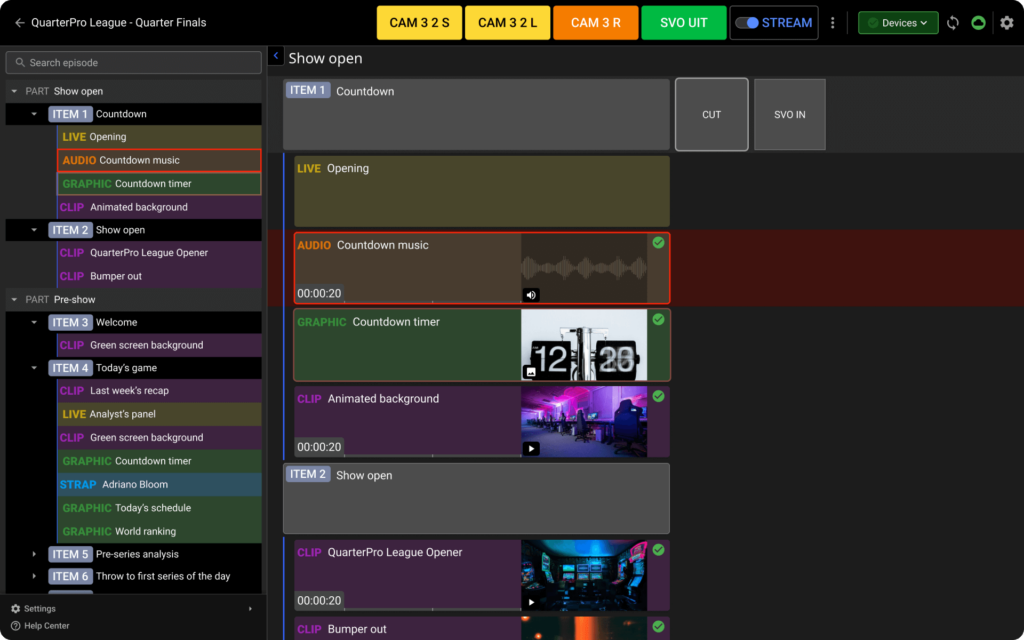
The Collaborative Rundown feature allows the crews to:
- Create and brainstorm simultaneously with the team on the rundown. All team members, on-site or off-site, can contribute, add notes, and discuss ideas.
- Link your rundown to all tools and devices with the automation module. Easily control lower thirds, tickers, or any media.
- Create specific Blocks connected to studio cameras, graphic servers, prompters, playouts, etc.
- Operate the show with a mouse click or a space bar – Cuez Automator will take care of the technicalities.
- Forget about a messy work environment. Both Cuez and TinkerList store everything securely in the cloud — easily accessible by anybody, at any time.

In addition, with the automated Rundown, the talk show teams can finally:
- Forget about tediously updating the rundown every time there’s a last-minute change in the script.
- Allow the engineers to store and playback (rehearse) media way before the show starts to avoid mistakes during the recording.
- Verify if the script has any errors (typos or incorrect lower thirds) to ensure a 100% error-free broadcasting experience.
Challenge #4: Keeping Track of (and Learning from) Timings
Timing is everything — especially in live talk shows. But delays are natural when the show isn’t 100% scripted and there are interactions with the guests that might side-track. Mastering the “art” of correctly timing a talk show can often be a nightmare.
Taking notes on timings and calculating delays
Usually, it’s the PA’s and Director’s role to keep track of timing and add hand-written notes to the script/rundown to know which part of the show was too long, where to make cuts (either during a live talk show or in the editing process of a pre-recorded show).
One moment of distraction can make a difference between a smooth editing process and a stop-and-rewind headache for the editor. If this process is entirely manual, the latter is usually what you’ll experience in the talk show post-production.
Want to know more about the Timings feature? Check out this Cuez Demo. If you want to know more about using timings in live TV production, check out our webinar.)
Automated Timing Calculations in Cuez
The Timing columns in the rundowns and scripts created in Cuez allow users to predict or record the duration of each segment in a talk show.
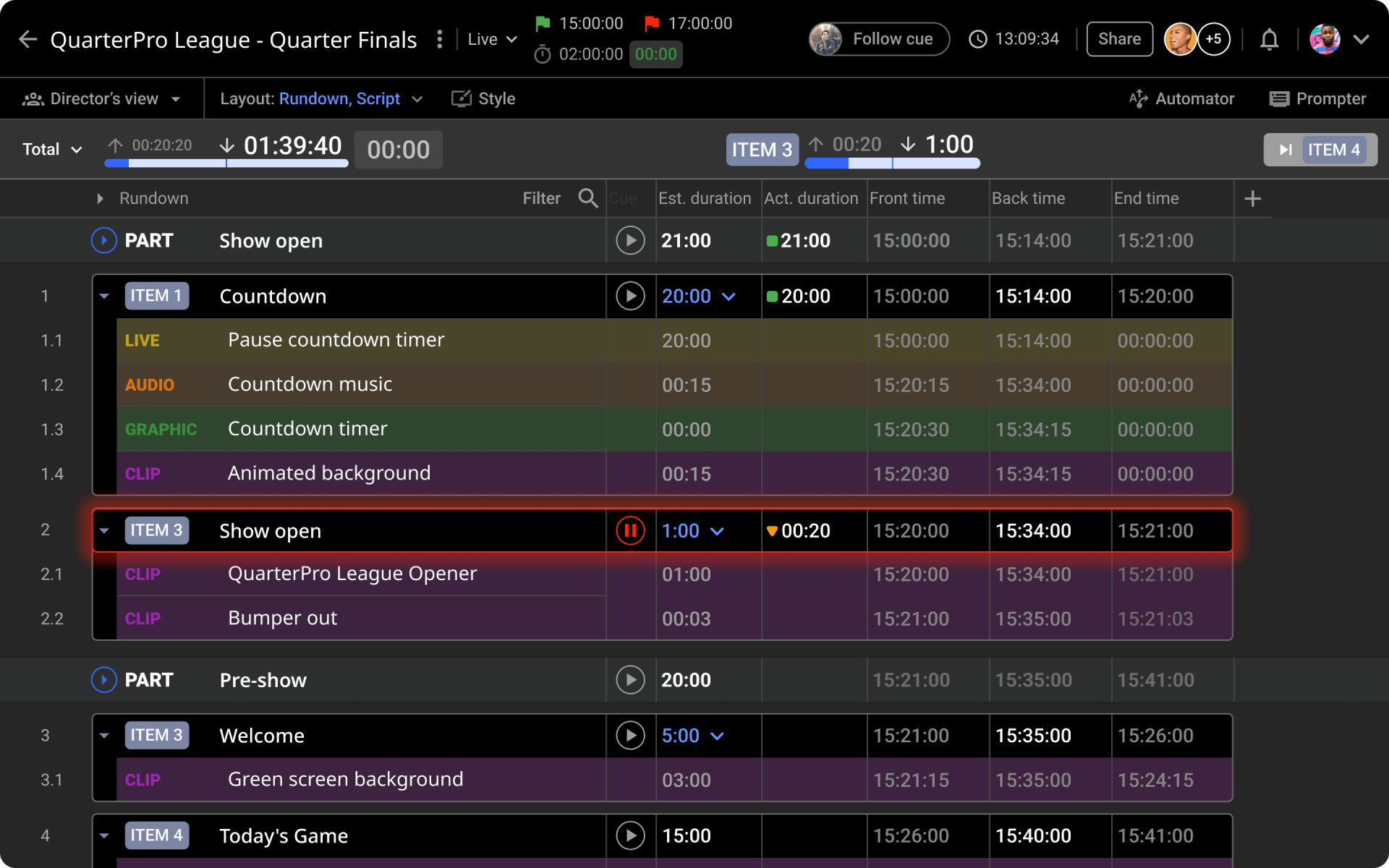

With this feature, the team can:
- Receive pre-calculated suggestions about how much time each segment would take based on the amount of content and media duration in each section.
- See detailed records on how much time each segment took, where there have been delays, etc.
- Control and manually adjust the duration of segments that have gone overtime to ensure the show ends before the air time passes.
(Want to know more about using timing in live TV production with TinkerList? Check out our webinar.)
Challenge #5: Talk Show Production Is Not Green
The TV industry is far from being ecological, but recent years have brought a new, positive trend called “Greener Broadcasting”. According to Jeremy Mathieu, producing a one-hour TV show corresponds to creating the same amount of CO2 (app. 13.6 tonnes) as three households over a span of one year!
Generating paper waste during talk show production
One of the elements of the talk show production that brings a climate threat is the excessive use of paper.
A single episode can “use” over 1,000 sheets of paper (e.g., 40 sheets of script per crew member, over 20 crew members, rundown printouts, cue cards for the host, documents, and reprints). That requires over 10,000 litres of water to produce. We have also calculated that one season of The Voice needs one mature tree worth of paper!
That is devastating to the environment.
Going paper-free and using integrations offered by Cuez
Cuez makes talk show production 100% paper-free. Not only thanks to the script and rundown features but also by sharing scripts and rundown in the tablet format. That works on iPad, Android, Windows tablets and even phones, making the traditional cue cards redundant.
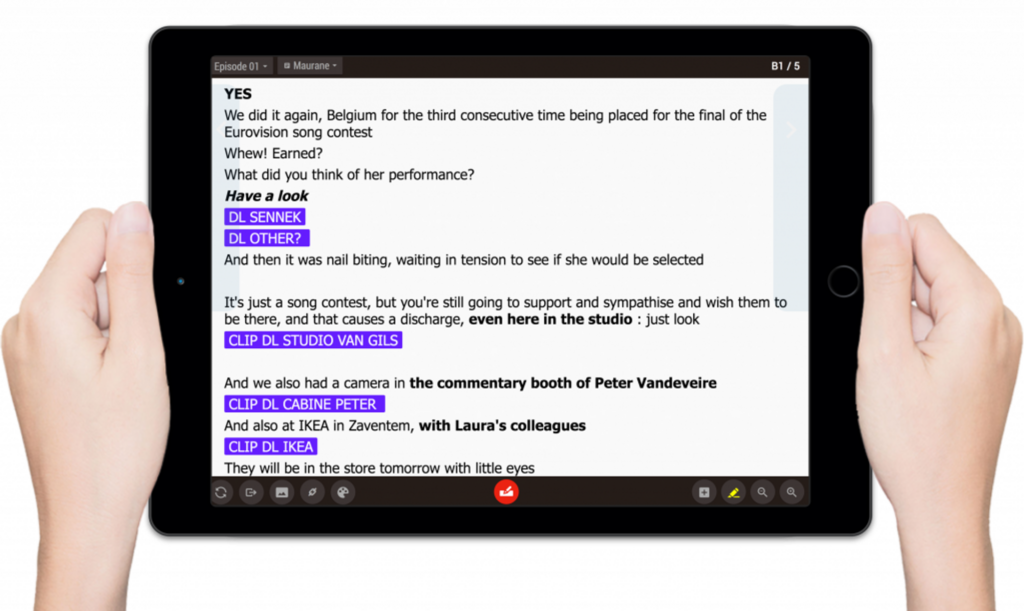
Our platform integrates with various software and hardware to ensure a seamless and paperless production process:
- vMix
- NewBlue
- Tricaster
- CasparCG
- OBS
- Viz Flowics
- SingularLive
- Blackmagic devices
- Some PTZ cameras, and many more…
The Future of Talk Show Production
Some of our team members have been working in the TV industry for decades. They observed how it evolves and responds to the crucial changes that have taken place over the years, such as:
- Ever-changing preferences of the TV audience (i.e. preference for more dynamic and fresh content).
- Competition from streaming platforms that are not constrained by airing time slots.
- Technological advancements (new hard- and software emerging every year).
- The new remote work culture, adopted after the COVID-19 breakout.
So what does the future look like for talk show professionals? We believe it has to be green, digital, automated, and collaborative. There’s no more room for messy printouts, excluding crew members, or unnecessary manual work.
Cuez or TinkerList aren’t the only ‘assistants’ available to talk show crews. We highly recommend checking out these tools:
- vMix (live production and streaming software)
- Singular (a platform for creating and controlling customisable overlays)
- Ross XPression (a real-time motion graphics generation system)
- NewTek TriCaster (a complete video production system)
- Grass Valey (the leading technology provider for the live media and entertainment market)
- EVS (live video production equipment provider that we highly recommend)
They all facilitate the production process, especially for the engineers who require more structure and automation than the creative team.
No matter what the future holds, the TinkerList team is here to create change. We hope in 10 year time, there’ll be no paper waste on the set, no nervous breakdowns or annoying mistakes.
We believe in that change because we’ve been bringing it to talk shows around the world since 2014!